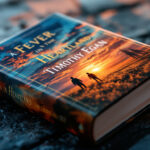Catching Fire by Suzanne Collins, Book Two in The Hunger Games Series
“Catching Fire” by Suzanne Collins, the second book in The Hunger Games trilogy, raises the stakes in every possible way. Set in the dystopian world of Panem, it follows Katniss Everdeen as she becomes an unwitting symbol of rebellion. With the shocking announcement of the Quarter Quell, past victors are forced back into the deadly arena, making survival even more personal. This book isn’t just about survival—it’s about resistance, sacrifice, and the emotional toll of living under constant control. With its gripping storyline, powerful themes, and unforgettable characters, Catching Fire cements its place as a fan favorite and a pivotal chapter in Katniss’s journey.
Overview of Catching Fire
Suzanne Collins’ Catching Fire picks up where The Hunger Games left off, thrusting readers back into the harsh, oppressive world of Panem. In this sequel, the stakes are higher, loyalties are tested, and the spark of rebellion begins to ignite across the districts. This section explores the key developments that set the stage for the story and raise its intensity.
Setting the Stage for Katniss Everdeen
The sequel begins in the aftermath of Katniss Everdeen and Peeta Mellark’s shocking victory in the 74th Hunger Games. Katniss is back in District 12, but her life is far from normal. The scars of the arena linger, both physically and emotionally. She battles recurring nightmares and struggles with the demands of playing her role as a Capitol darling to avoid attracting President Snow’s wrath. Her experiences in the arena have left her wary, with a heightened sense of survival and distrust.
Meanwhile, Panem is simmering with unrest. Katniss’ defiance during the previous Games—the act of threatening to consume poisonous berries alongside Peeta—has inspired hope and rebellion in the districts. This defiance hasn’t gone unnoticed. President Snow himself warns her that her every move is being watched, and he expects her to quell any signs of dissent. The fragile peace in Panem is beginning to crack, and Katniss is now a symbol of hope, whether she wants to be or not.
For additional insight into the plot, you can check out this comprehensive summary of Catching Fire.
Introduction of the Quarter Quell
Central to the storyline is the announcement of the 75th Hunger Games: the Quarter Quell. Every 25 years, the Capitol introduces a horrifying twist to the Games, and this time, it’s a deeply personal one. For the Quarter Quell, past victors are required to compete against each other, ensuring an arena filled with the deadliest tributes in Panem’s history.
This twist is both shocking and strategic. It’s a calculated move by the Capitol to reassert its dominance and snuff out the growing seeds of rebellion. By forcing Katniss and other victors back into the Games, the Capitol aims to neutralize them as symbols of resistance. For Katniss, it represents not only a return to the physical dangers of the arena but also the emotional weight of protecting the people she cares about.
The introduction of the Quarter Quell adds a layer of intensity that transforms the narrative into something much larger than survival. It becomes a battle for identity, loyalty, and the very idea of freedom. To dive deeper into how the Quarter Quell impacts the plot, check out this Catching Fire summary and study guide.
As the story progresses, you’ll feel the weight of Katniss’ journey and the escalating tension in Panem. This pivotal twist sets the stage for a gripping and suspenseful continuation of the series.
Central Themes in Catching Fire
Suzanne Collins’ Catching Fire is more than a sequel; it’s a layered exploration of universal themes that resonate deeply. From the raw struggles of survival to the slow burn of rebellion and the overpowering influence of propaganda, each theme shapes the narrative while examining the complexities of human nature and society. Let’s dive into these central ideas.
The Struggles of Survival
Survival is at the heart of Catching Fire, and Collins masterfully portrays it not only as a physical challenge but also an emotional and psychological burden. In the 75th Hunger Games arena, survival demands constant vigilance and sharp instincts. The victors-turned-tributes find themselves grappling with new dangers like toxic fog and carnivorous monkeys, while also navigating fragile alliances. These life-or-death choices drive home the brutal reality of survival in Panem.
Beyond the arena, survival takes on a quieter but equally pressing form. For Katniss, maintaining the facade of a happy victor to appease the Capitol is an exhausting battle. Her every word and action are scrutinized, forcing her to constantly walk a precarious tightrope. This dual struggle reflects the broader theme of survival in an oppressive regime—where staying alive often means compromising personal values.
The Rise of Rebellion
A growing sense of defiance fuels the narrative in Catching Fire. While much of the rebellion simmers below the surface, Collins gradually unveils how acts of defiance spark hope across Panem. Katniss and Peeta’s shared victory with the poison berries in the first Hunger Games sets the stage for a rebellious undercurrent. This “boy-and-girl-on-fire” duo unwittingly becomes a rallying symbol for oppressed districts yearning for liberation.
Subtle symbols of rebellion are woven throughout the book. The mockingjay—representing resilience and defiance—continues to play a pivotal role as a sign of resistance. Every defiant act, even Katniss’ costume transformation into a burning mockingjay during the Capitol festivities, hints at something bigger. These moments build momentum toward open rebellion, shaking the Capitol’s grip and sowing seeds of change.
The Role of Media and Propaganda
In Catching Fire, media functions as a weapon of both control and resistance. The Capitol manipulates television broadcasts to maintain power, crafting elaborate narratives that enforce fear and dependency. From Caesar Flickerman’s charmed interviews to the gory spectacle of the Hunger Games, the Capitol uses media to present itself as invincible and benevolent.
Yet, this weapon cuts both ways. Katniss and her allies begin to wield media for their own purposes, challenging the Capitol’s dominance. One example is her fabricated romance with Peeta, which becomes a double-edged sword—beneath the facade of their love story, rebellion brews. The use of media as propaganda underscores how messages can shape perceptions, both for good and ill.
For a deeper exploration of the themes in Catching Fire, you can read this Goodreads review highlighting its layered storytelling.
Through its relentless focus on survival, rebellion, and propaganda, Catching Fire reveals how large-scale struggles reflect very personal battles. These themes bring depth and urgency to Katniss’ journey, making the novel a striking examination of human resilience.
Character Development
The heart of Catching Fire lies in its remarkable character development. Suzanne Collins doesn’t just thrust her characters into a treacherous new arena; she allows them to evolve in ways that feel authentic, relatable, and emotionally resonant. This section explores the growth of key characters and how these changes enhance the story’s depth.
Katniss’ Evolution
Katniss Everdeen undergoes significant growth as she transitions from a survivor in The Hunger Games to a reluctant but emerging leader in the rebellion in Catching Fire. Initially, Katniss is overwhelmed by the psychological scars of the first Games and the moral weight she carries from defying the Capitol. She’s trapped between the Capitol’s demand for compliance and her unintentional status as a symbol of rebellion.
Her transformation is gritty and realistic, driven by the people around her and her growing awareness of the rebellion. As the Quarter Quell forces her back into the arena, Katniss begins embracing her instincts to protect rather than just survive. This includes not only shielding Peeta but also allies like Wiress, Beetee, and others. Every choice she makes reflects her growing realization that her fight is no longer just about her personal safety, but about the freedom of Panem’s people.
Katniss becomes a more nuanced character in this installment. Her inner conflict about being a rebel leader versus wanting to protect her family presents a compelling dimension. For more insights into how Katniss’ character evolves in “Catching Fire,” you may find this detailed Hunger Games commentary insightful.
Peeta Mellark’s Loyalty and Courage
Peeta Mellark continues to be an emotional anchor in the story, his arc highlighting loyalty and quiet bravery. Peeta’s dedication to Katniss—real or orchestrated—remains a central theme in Catching Fire. He is deeply protective and selfless, going to great lengths to ensure Katniss’ survival, even at the expense of his own well-being.
What sets Peeta apart is his ability to wield empathy as strength. In a world where brute survival often takes precedence, Peeta focuses on building alliances, offering unwavering support, and leveraging his natural charisma to counter the Capitol’s oppressive tactics. The way he uses his words to inspire both fear and hope is a testament to his strategic mind.
Peeta’s actions in the Quarter Quell solidify him as more than just Katniss’ companion. From his clever strategies to his heart-wrenching vulnerability, Peeta proves that courage doesn’t always roar—it can manifest in small but powerful moments of selflessness.
New and Returning Faces
Catching Fire broadens its scope with a richer ensemble of supporting characters that enhance the storytelling. The inclusion of both familiar and new faces brings complexity and intrigue to the narrative.
- Familiar Victors: Characters like Haymitch Abernathy and Effie Trinket return, each with their own struggles. Haymitch remains a cynical yet deeply clever mentor, while Effie undergoes subtle but impactful changes as she begins to question the Capitol’s cruelty.
- New Allies: The introduction of victors like Finnick Odair and Johanna Mason adds depth and unpredictability. Finnick, with his charisma and hidden pain, emerges as an intriguing ally for Katniss. Johanna’s sharp wit and brutal honesty remind us of the Capitol’s lasting impact on all victors.
- Enemies and Enigmas: President Snow’s calculated moves reinforce his role as a chilling antagonist. Meanwhile, Plutarch Heavensbee, the new Head Gamemaker, keeps us guessing about his true intentions as he maneuvers within the Capitol’s framework.
This ensemble reflects the broader themes of survival and rebellion. Each character, with their unique scars and strengths, underscores the brutal reality of Panem. To explore how these characters contribute to the layered storytelling, you can read this review of Catching Fire characters.
By expanding the cast and diving deeper into their motivations, Collins ensures the story isn’t just about one person’s evolution—it becomes a tapestry of resilience, unity, and defiance. Each character’s journey enhances the stakes, making Catching Fire an unforgettable chapter in the series.
Suzanne Collins’ Writing Style
Suzanne Collins has a unique ability to balance compelling storytelling with meaningful depth, and her writing in Catching Fire exemplifies this talent. The second installment in The Hunger Games trilogy reveals a more detailed world, cranks up the suspense, and weaves in powerful symbols—all while keeping readers eager to turn the page. Her style combines clear, succinct prose with layered subtext, allowing the narrative to resonate on multiple levels.
World-Building in Panem
In Catching Fire, Panem’s world transforms from a dystopian backdrop into a fully realized setting, filled with complexity and nuance. Collins expands on the political and social structures that drive the Capitol’s iron grip over the districts. Each region gets more distinct traits, highlighting the imbalance between the Capitol’s opulence and the districts’ suffering. For instance, we see District 12’s utter poverty juxtaposed with the Capitol’s grotesque extravagance during the Victory Tour.
The arena design for the Quarter Quell also shows her creativity in world-building. Collins doesn’t just create an arena for entertainment but one that serves the Capitol’s goal of psychological manipulation. The clock-like design, with its changing dangers, adds a macabre twist while emphasizing the Capitol’s control over life and death. These vivid settings draw readers deeper into Panem’s chilling reality.
You can almost feel the heat of the tropical arena, sense the static of rebellion in the air, and hear the haunting hums of the Capitol’s systematic oppression. Collins uses these environmental details to amplify tension and underscore the stakes. Every element strengthens Panem’s role as both a physical space and a symbol of corrupted power.
Pacing and Suspense
Collins’ mastery of pacing ensures that Catching Fire grips readers from start to finish. She weaves moments of quiet reflection with bursts of action, never allowing the narrative to stagnate. The twists keep piling on, from the Victory Tour’s uneasy encounters to the grim announcement of the Quarter Quell. Just as Katniss thinks she has a breath to spare, Collins introduces another challenge, maintaining an edge-of-your-seat rhythm.
The suspense isn’t just driven by plot; it’s also psychological. Katniss’ internal battle—her fear of President Snow’s threats, her uncertainty about who to trust—adds layers of tension. Collins writes characters who exist on the edge of survival, making their decisions not just difficult but sometimes morally conflicting. This builds a visceral connection between the reader and the story.
Every scene feels deliberate, with chapters often ending on cliffhangers that compel you to keep reading. Whether it’s a shocking reveal, a subtle betrayal, or a looming threat, Collins knows how to keep the stakes high without overwhelming the reader.
Use of Symbolism
Symbolism is a cornerstone of Collins’ storytelling, and Catching Fire takes it to another level. Among the most prominent symbols is the mockingjay, which evolves from a mere bird to a powerful emblem of resistance. Originally an accidental byproduct of the Capitol’s experiments, the mockingjay’s survival becomes a metaphor for defying oppression. For Katniss, wearing the mockingjay pin isn’t just a personal token—it’s a statement of defiance. By the end of the book, it represents the growing unity among the oppressed districts.
Fire, too, carries layered meanings throughout the series. While it’s often associated with Katniss’ fiery spirit or the Capitol’s destructive tendencies, Catching Fire uses it to symbolize both destruction and rebirth. The title itself suggests a spark igniting into an uncontrollable blaze, mirroring the rebellion gaining momentum across Panem.
Other symbols, like the poisonous berries that reappear in allegorical gestures, reinforce the themes of choice and sacrifice. The arena’s clock design is equally symbolic, representing the Capitol’s relentless control and the looming inevitability of time and rebellion. These motifs don’t merely decorate the narrative; they add depth and provoke thought, leaving a lasting impression on the reader.
Impact and Legacy of Catching Fire
Catching Fire, the second book in Suzanne Collins’ The Hunger Games trilogy, has left an indelible mark on both literature and popular culture. It resonates deeply with readers while providing a rich foundation for its cinematic adaptation. Let’s explore how the book continues to engage audiences and how its adaptation has cemented its legacy.
Resonance with Readers
The themes and characters in Catching Fire strike a chord with readers across generations. At its core, the book explores struggles against oppression, the cost of defiance, and the complexities of human connections—all themes that feel universally relatable. Katniss Everdeen, as a protagonist, shines not because she’s perfect, but because she’s flawed and deeply human. Her internal conflict about taking on the role of a revolutionary figure is one many can empathize with, especially in a world filled with societal expectations and pressure.
Moreover, the Quarter Quell setup captures readers’ imaginations, turning the concept of the Games into a metaphor for larger battles—both societal and personal. The introduction of victors from past Hunger Games adds layers of complexity, forcing readers to grapple with questions of loyalty, survival, and justice. These elements make Catching Fire a springboard for thought-provoking discussions, whether among book clubs or in classrooms.
The novel’s influence extends even to educational settings. Some educators have leveraged Collins’ trilogy to connect with students and introduce deeper literature concepts. For example, discussions on dystopian themes and moral dilemmas are now a staple of language arts curriculums in many schools. For more insights on its broad appeal, this article highlights how it’s even used in teaching rural schools.
The Film Adaptation
The 2013 film adaptation of Catching Fire further magnified the book’s popularity, bringing its intense narrative to life for a global audience. Directed by Francis Lawrence, the movie retains the book’s soul, sticking closely to the original plot while enhancing certain elements with a visual language the book couldn’t express. For instance, President Snow’s scheming feels even more ominous on screen, giving deeper insight into his manipulative, cold-blooded nature.
While the essence of the story remains intact in the film, some moments that required trimming for time raised debates among fans. Details such as Katniss’ encounters with Bonnie and Twill in the book were left out, while others, like Peeta’s ability to swim, were subtly tweaked. Those changes, however, don’t overshadow the film’s success in conveying the emotional and thematic gravity of the original story. You can read this in-depth analysis of differences between book and film to see how the adaptation made certain creative adjustments.
Fans often praise the adaptation for staying true to the heart of the original, even enhancing some aspects (like visual effects and arena design) that the book could only hint at with words. The tropical arena, for example, was brought to life vividly, with a lush, dangerous landscape that heightened the danger and emphasized the Capitol’s control. For a detailed exploration of the movie’s strengths, this review dives into why Catching Fire is considered the best film in the series.
Ultimately, Catching Fire, both as a book and a film, has become a cultural touchstone. Its story endures because it taps into universal feelings—fear, hope, defiance—wrapped in a gripping narrative that refuses to let go. By sparking conversation and inspiring adaptation, its legacy not only persists but continues to grow.
Conclusion
Catching Fire proves itself as a standout sequel, combining thrilling action with deep social and political themes. It takes readers on an unforgettable journey through a world where rebellion simmers beneath the surface, driven by a protagonist whose resilience and complexity shine. Suzanne Collins masterfully balances moments of hope and despair, crafting a story that lingers long after the final page.
This book isn’t just a gripping dystopian tale; it’s a powerful commentary on survival, identity, and the fight for freedom. Whether you’re a longtime fan of The Hunger Games or new to the trilogy, Catching Fire is a must-read that solidifies its place as a cornerstone of modern young adult fiction.
Ready for more? Dive into the series and witness how Katniss Everdeen’s journey shapes the fate of Panem. Share your thoughts or continue exploring the memorable themes and characters that make this story so impactful.







